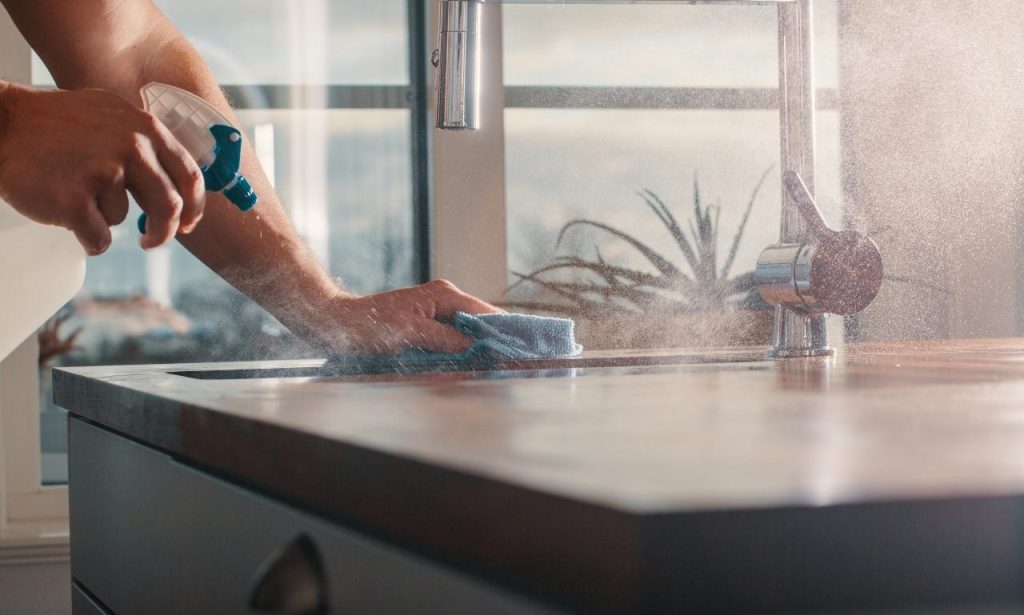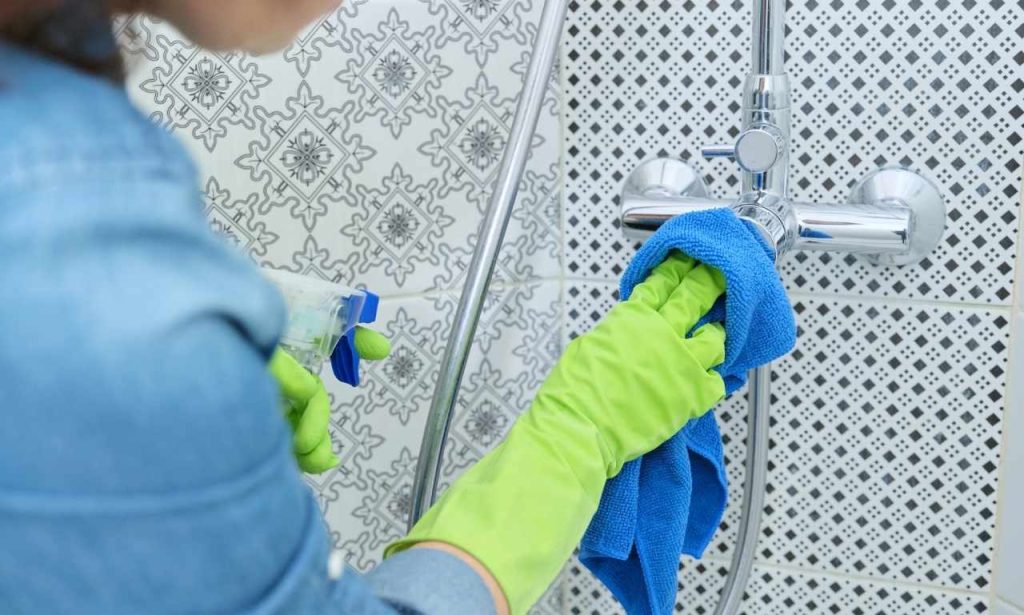Creating a clean dwelling should not require mountain-climbing effort. Clean homes exist without lengthy all-day cleaning schedules. Proactive steps should be taken before the disorder gets out of control. Keeping your house clean is similar to maintaining dental hygiene since both practices prevent bigger difficulties from emerging. People usually wish to achieve results without needing to work, but the truth remains that this type of outcome requires actual labor. Let us discuss how to keep a clean house with minimal effort.
How to Clean the Kitchen

Kitchens get gross fast. Culinary preparation, cooking splatters, and whatever goes on inside the refrigerator easily transform them from an organized space into a messy disaster zone.
Keep Dishes Clean
Dishes multiply like rabbits when you’re not looking. The secret? Never let them pile up. Five years back, I started washing pots while my food cooked. Game-changer. The sink stayed empty, and my morning mood improved dramatically.
Fill the sink with soapy water as you cook. Toss utensils and bowls in as you go. Dried food requires nuclear-level scrubbing, but fresh residue wipes away easily. Hot water tackles grease; cold water handles dairy and eggs better. Running the dishwasher at night means waking up to clean dishes, which sets a positive tone for the day.
Clean Your Sink
Few people realize kitchen sinks harbor more bacteria than toilet seats. Daily attention prevents this invisible buildup. Wipe the basin and handles after washing dishes. Sprinkle baking soda once weekly and rinse with hot water. Skip abrasive cleaners on stainless steel—they leave permanent scratches that collect more grime.
Stash cleaning wipes nearby for quick maintenance. Pour boiling water down the drain occasionally to flush out accumulating gunk. This prevents clogs and eliminates that mystery smell you’ve been ignoring.
Keep Surfaces Clean
Countertops are clutter magnets. Mail, keys, half-empty coffee cups—they all land here. Clear surfaces make even modest kitchens look cleaner. Wipe counters immediately after cooking. Those sauce splatters turn to cement overnight.
Store appliances in cabinets when possible. Each visible item makes a kitchen look busier. Use cutting boards religiously. Different countertop materials need specific care: marble hates acid, laminate tolerates most cleaners, and granite needs specialty products. Keep diluted cleaner in a spray bottle for impromptu wipe-downs.
Tackle the Refrigerator
Forgotten leftovers shouldn’t develop civilizations. Check for expired food weekly. Wipe spills immediately—dried ketchup fights back harder. Line produce drawers with paper towels to catch debris. Replace weekly for fresher produce.
Clean handles frequently; they’re touched after handling raw foods. Keep baking soda inside to absorb odors. Organize similar items together to prevent food from vanishing into the back corner dimension. Deep clean quarterly by removing everything, but regular maintenance makes these big cleans less traumatic.
Take Out the Trash in a Timely Fashion
Kitchen trash stinks. Period. Empty it regularly, even when not full. Use odor-blocking bags. Sprinkle baking soda at bin bottoms to absorb leaks and neutralize smells. Consider a smaller trash can—it forces more frequent emptying.
Clean the bin monthly, focusing on the rim and lid underside where sticky residue collects. Keep trash away from heat sources, which accelerate decomposition. A tight-fitting lid prevents both smells and curious pets from investigating.
How to Clean the Bathroom

Bathrooms combine moisture, bacteria, and personal grooming debris. It’s the perfect storm for grossness.
Scrub the Shower and/or Tub, Sink and Toilet
Daily shower spray prevents soap scum and mildew. Keep a squeegee handy for a quick post-shower wipe-down. This thirty-second habit saves hours of scrubbing later. Clean toilet bowls twice weekly minimum. The brush should reach under the rim where nastiness hides.
Bathroom sinks need daily attention—toothpaste and makeup residue cement themselves overnight. Shower cleaning tablets provide continuous maintenance between deep cleans. Stash bathroom wipes under the sink for quick touch-ups whenthe company’s coming.
Hair Management
Hair gets everywhere. Place mesh traps over all drains. Empty after each shower. Brush hair before bathing to capture loose strands before they clog pipes. Use a rubber squeegee on bathroom floors after showers to collect hair before it migrates.
A small handheld vacuum in the bathroom cabinet makes quick cleanups possible. Clean hairbrushes weekly—they collect shocking amounts of dust and dead skin cells along with hair. Consider shower caps during non-washing days to reduce drain clogs.
How to Clean Your Bedroom
Bedrooms should feel peaceful. Clutter disrupts sleep and increases stress hormones.
Make Your Bed
This two-minute task transforms room appearance instantly. The visual impact dramatically outweighs the effort required. Simplified bedding speeds the process—duvets with covers eliminate multiple layers.
Try the military corner technique for efficiency. Tucked sheets stay put longer. Making your bed creates momentum for other cleaning tasks. The psychological benefits extend beyond appearances. Studies confirm that bed-makers sleep better and report lower stress levels.
How Often You Should Wash Your Sheets
Sheets collect skin cells, sweat, and dust mites. Weekly washing prevents allergen buildup. Keep multiple sets for easier rotation. Remove sheets directly into the washing machine to prevent spreading dust throughout the bedroom.
Use hot water to kill dust mites. Consider allergen-reducing detergents for sensitive individuals. Pillowcases need more frequent washing—they collect facial oils and products directly. Air out your mattress while changing sheets to release trapped moisture.
Put Clothes Away
Clothing creates most bedroom chaos. The one-touch rule prevents this: either hang it up, place in hampers, or return to drawers immediately. No “chair purgatory” for partially worn items.
Keep hampers in convenient spots to encourage use. Simplify closet organization for easier maintenance. Create a five-minute pickup routine before bed. Fold clean laundry immediately after washing—the longer it sits in baskets, the less likely it returns to proper storage.
How to Clean the Living Room
Living rooms face the heaviest traffic and most diverse activities. They collect evidence of everyone’s habits.
Remove That Which Does Not Belong
Living rooms become dumping grounds for items from throughout the house. Use a “doesn’t belong here” basket for quick cleanup. Empty it daily, returning items to their proper homes. Train family members to take one misplaced item when leaving the room.
Establish a ten-minute evening reset routine. The entire family can participate for faster results. Create homes for commonly misplaced items like remote controls. Decorative baskets conceal clutter quickly when unexpected visitors arrive. Consider minimizing decorative items that collect dust—fewer things mean faster cleaning.
Straighten and Square
Alignment matters. Straighten cushions and pillows daily. Square off stacked magazines. Fix crooked rugs. Arrange remotes in designated holders. These micro-adjustments take seconds but dramatically improve appearance.
Even cluttered rooms look better with organized elements. Train yourself to notice misalignments while walking through rooms. These small interventions prevent bigger cleaning sessions later.
How to Clean a Couch
Upholstery collects crumbs, dust, and body oils. Vacuum weekly using proper attachments. Address spills immediately—blot, don’t rub. Check manufacturer tags for cleaning codes before applying products.
Rotate cushions monthly to distribute wear. Steam clean fabric upholstery twice yearly. Consider protective covers for homes with kids or pets. Keep fabric cleaner nearby for immediate spot treatment. Test new products on hidden areas first to prevent damage.
How to Clean Wood Floors
Wood floors show every speck of dust. Sweep or dust mop daily in high-traffic areas. Use microfiber for better dust capture. Check whether your floors have surface or penetrating seals—this determines appropriate cleaning methods.
Clean spills immediately to prevent water damage. Use only manufacturer-recommended products. Harsh chemicals can permanently damage finishes. Place mats at entrances to reduce tracked-in dirt. A no-shoes policy dramatically reduces cleaning needs.
How to Clean Your Car

Vehicle interiors become extensions of our homes, collecting surprising amounts of debris. Keep a small trash container in your car and empty it during gas station stops. Wipe dashboard surfaces weekly with appropriate cleaners.
Vacuum floors and seats monthly at minimum. Remove and shake floor mats weekly for faster cleaning. Keep dashboard wipes in your glove compartment for quick cleanups during waiting moments. Address spills immediately before they become permanent stains. Different seat materials need specific care—leather requires conditioners while fabric benefits from stain protection.
Tidying Up After Pets and Kids
Pets and kids create unique messes requiring specific approaches.
Pet hair demands regular attention. Use lint rollers for quick furniture touch-ups. Vacuum high-use areas twice weekly. Designate specific pet blankets on furniture—these wash more easily than cleaning upholstery. Keep pet toys contained in baskets. Wash pet bedding weekly to control odors. Place washable mats under food and water bowls to catch spills. Keep pet wipes handy for muddy paws. Consider furniture covers in homes with heavy shedders.
Kids create messes as part of development. Implement quick cleanups before activity transitions to prevent material buildup. Teach age-appropriate cleaning skills. Create accessible storage at child height to encourage independent cleanup. Use washable art supplies when possible. Keep cleaning wipes accessible for spill response. Schedule brief family cleanup sessions before bedtime to distribute responsibility. Designate homework areas to contain paper clutter. Use lidded storage for toys with small pieces.
The Cleaning Supply Closet
Organized supplies enable faster cleaning. Store products near usage areas to reduce walking time. Keep basic cleaning kits on each floor. Include microfiber cloths, all-purpose cleaner, and disinfectant wipes.
Group similar products together. Label shelves for faster replacement. Choose multi-purpose cleaners to reduce product variety. Create grab-and-go caddies for specific tasks. Bathroom supplies work best stored in bathrooms. Kitchen supplies belong under the sink. Regularly check and replace depleted items. Consider environmentally friendly options—they often perform equally well with fewer health concerns.
Conclusion
Maintaining a clean house doesn’t require martyrdom. Small daily interventions prevent cleaning emergencies. The secret lies in preventing messes rather than battling established ones. Start with areas that frustrate you most—build momentum through visible improvements.
Remember that “clean enough” beats perfection. A functional, generally tidy home is better than an immaculate showpiece that causes anxiety. Adjust these strategies to fit your household’s unique needs. Each positive habit builds on previous successes, creating momentum that makes the process increasingly automatic. Your future self will thank you for starting today.
Also Read: How to Fix Small Holes in Drywall
FAQs
Quarterly works for most homes, with regular maintenance between sessions.
A ten-minute pickup, wiping kitchen counters, and making beds covers the essentials.
Assign age-appropriate tasks and schedule short family cleaning sessions with upbeat music.
All-purpose cleaner, microfiber cloths, vacuum, and disinfectant wipes handle most situations.


